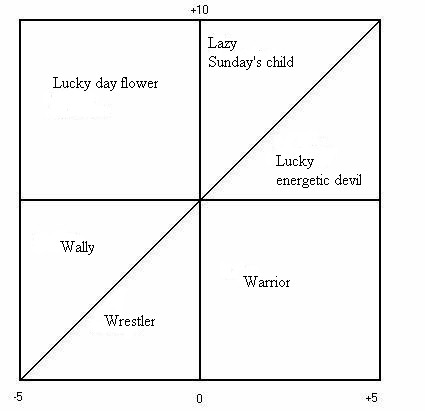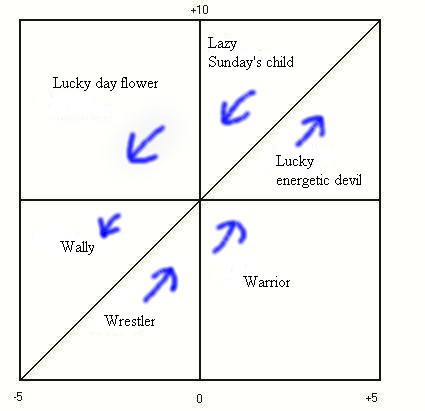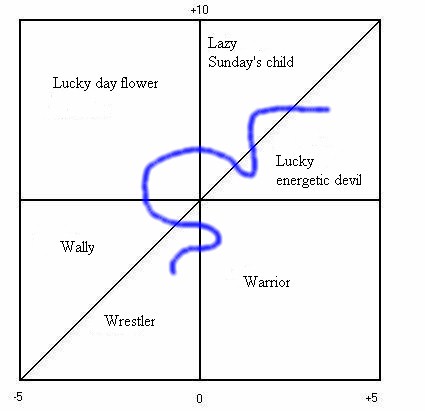
Chapter
4 Six lucky types
The
graph below summarizes the numeric approach from chapter 3. Horizontally - from
left to right - subjective happiness is included, expressed in a number from -5
to +5. Vertically, upwards, is the objective scale, expressed in a number from 0
to 10. In the very upper right corner you can find the ultimate lucky guys who
do not only have everything they want, but also feel it that way. In the very
lower left corner are the very unhappy people who also feel that way.
The diagonal can be considered as the line that indicates how happy a person
should feel, considering the level of objective happiness of that person. Left
to the diagonal are pessimistic and less energetic people who feel less happy
than they should be. On the right are the optimistic and energetic/experienced
people who grasp more happiness out of life than they objectively have.

In the lower half of the table we find the people who are unhappy from an objective perspective. To the right are the people who despite all their objective unhappiness nevertheless say that they have enough energy, experience etc. to feel at least happy. They scored more than 0 for their subjective happiness. Even when they do not have a lot of luck in their lives, they can cope with it and try to do something about their objective unhappiness. This kind of person we call a warrior.
In the lower left corner of the graph we may find people who are not happy and also do not feel so. Two types of people can be distinguished. On the left side of the diagonal are people who even feel less happy than they should objectively be. Because of their self-pity, they do not invest at all in the small amount of happiness they still have. These people often find themselves in a vicious circle downwards. This kind of person we call a walley.
On the right side of the diagonal are people who indicate that their objective happiness is rather low, that they also don't feel very happy, but still more than you may expect on the basis of the objective figure. They feel less unhappy than they should. For this type there is still hope and we call this kind of person a wrestler.
Then in the upper half of the graph we find lucky people who score more than 5 on average for the objective indicators. Also here three types can be distinguished.
The lucky dayflower is someone who should be happy, because his life is not so bad after all. But this type often complains, and has little energy and life experience. Sometimes they have everything they want, except for the drive to enjoy it. In the graph you can trace this person in the upper left corner.
Then we still have the real lucky guys. Their objective happiness is high enough and they also feel all right. Still the lucky ones who are left of the diagonal could do a little bit better. They are not doing very bad, but could do more to improve their situation. Therefore we call this person a lazy Sunday's child.
Finally, we have the lucky energetic devils. They are happy and do everything to keep it that way. They only should be careful not to overdo things and become too tiresome for people around them.
In the past (ch. 3), we already mentioned the future. We then concluded that if under the impact of our strange feelings total happiness is less than it should be from an objective point of view, future look gloomy. On the other hand, when total happiness is larger than the objective happiness, the future is bright.

In the graph this is represented by the fact that all arrows to the right of the diagonal are upwards. This means that the future for these people will bring a larger objective happiness. Through their relatively high level of energy, life experience and stability, they might be able to acquire more wealth, social contacts en health. In this way, also their subjective happiness will increase. It is a kind of upward vicious circle. The wrestler will turn into a warrior and the warrior will find himself in the upper half of the graph. At the end everybody will become a lucky energetic devil.
Of course until the stock exchange or the partner will crash when everything starts again from the beginning.
A similar reasoning is true for all the downward arrows to the left of the diagonal. Future will only bring more misery for these people. Their objective happiness will decrease. Through their apathy, isolationism, capriciousness and na´vetÚ they will become impoverished, lonely and sad. That makes that they will feel even unhappier and find themselves in a downward vicious circle. The lazy sunday child is in no time a walley. Of course until they win the first prize in the lottery or fall in love with a beautiful cover girl.
Of course this picture is somewhat black and white. Most people move around the diagonal and will be sucked up and down in their lives. Objective indicators can change suddenly by winning money and meeting people. With respect to the subjective factors we have our periodical fluctuations in energy and stability. Look at my graph for the last three years.

But most certainly we are not fully dependent on the flows around us and we can swim against the stream if we only want.
In the next two chapters we will focus on investing in objective and influencing subjective happiness.
Home
(questionnaire)
Chapter 1: objective happiness
Chapter 2: subjective happiness
Chapter 3: combining objective and subjective
happiness
Chapter 4: six types of
happiness
Chapter 5: Influencing subjective happiness
Chapter 6: Investing in
objective happiness